Rosenshine's Principles: A teacher's guide
Rosenshine's principles of instruction: a classroom guide on the theory and practice for teachers and educational leaders.


Rosenshine's principles of instruction: a classroom guide on the theory and practice for teachers and educational leaders.
Barak Rosenshine wanted to know what made great teachers great. Between 1986 and 2010, this University of Illinois professor studied classrooms, reviewed cognitive science research, and identified patterns that separated clear teaching from average teaching.
The result was seventeen principles that work. Not theory. Not guesswork. These came from watching teachers whose students consistently made the strongest progress on attainment tests.
Rosenshine built his framework on three foundations. First, he examined cognitive science research on how students acquire and retain new information. Second, he observed master teachers in action, noting how they introduced content through modelling, linked new ideas to prior knowledge, checked understanding, and structured practice. Third, he studied research on scaffolding and cognitive supports that help students tackle difficult concepts.
Barak Rosenshine died in 2017, but his principles remain central to teacher training across the UK. They connect directly to how our brains process information. Working memory has limits. Long-term memory needs specific conditions to store new knowledge. These principles address both constraints.
Teachers using Rosenshine's approach create classrooms where students understand more and remember longer through mastery learning. This connects directly to the concept of visible learning, where teaching methods make student progress transparent and measurable. The principles guide questioning, practice design, and lesson structure. They work across subjects and age groups because they're rooted in how all humans learn, making them particularly effective for direct instruction approaches.
This article breaks down each principle and shows how to apply them in your classroom. If you lead teaching and learning in your school, you'll also find guidance on professional development and implementation. These aren't checklist items. They're high-level concepts that require understanding before you can apply them well. Once you grasp the cognitive science principles behind them, you can adapt your daily teaching to fit your students' needs.
The Structural Learning Thinking Framework aligns with Rosenshine's emphasis on explicit instruction and retrieval practice. When you combine both approaches, you give students clear cognitive pathways and practical tools for organizing their thinking.
You can download a visual summary of all seventeen principles as a PDF. Use it for CPD sessions, staff meetings, or your own planning. The graphic format makes the principles easy to reference when designing lessons or observing colleagues.
Rosenshine's most effective methods include daily review, presenting new material in small steps, asking questions to check understanding, providing models, guiding student practice, and obtaining high success rates. These methods work by preventing cognitive overload and strengthening connections between working memory and long-term memory. Teachers who implement these methods consistently see stronger student progress on attainment tests.
Rosenshine's principles of instruction have garnered significant attention in recent years for offering a set of flexible, evidence-informed guidelines that can be adapted to suit various teaching contexts. These principles are not rigid frameworks but rather guiding methods designed to help teachers enhance their practice while maintaining professional autonomy. In the UK, where schools increasingly value , Rosenshine's methods provide an excellent foundation for fostering clear teaching behaviours. However, for these principles to truly succeed, it is essential that teachers understand the rationale behind them. Without this clarity, there is a risk of superficial adoption without meaningful impact.
To begin, lessons should start with a brief review of prior learning, ensuring students are prepared to engage with new material. When introducing new concepts, teachers should do so in manageable steps, allowing students to practice after each step to solidify understanding. To prevent cognitive overload, it is crucial to limit the amount of new material introduced at one time and provide clear, detailed instructions and explanations. Teachers should ask many targeted questions to test understanding and ensure clarity, guiding students as they begin practicing new skills.
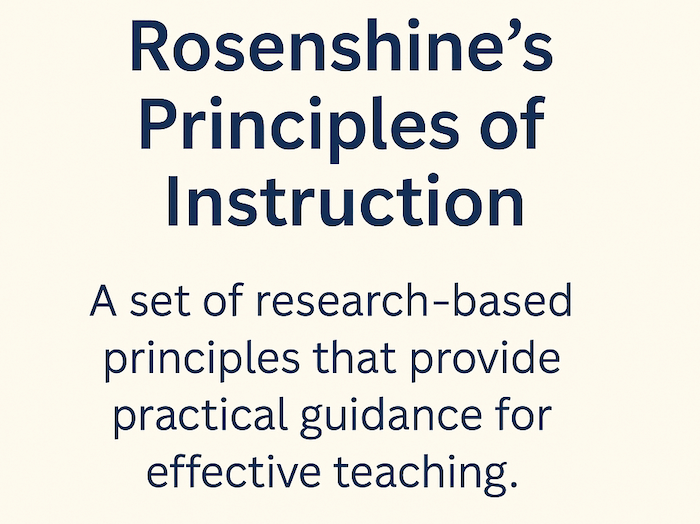
Active, is essential for students to develop proficiency. Teachers should model processes explicitly, using worked-out examples to illustrate steps clearly. Students should then demonstrate their understanding, enabling teachers to check their responses and provide corrections or feedback as needed. Complex material may require re-teaching to ensure comprehension. Teachers should allocate ample time for clear explanations, reinforcing key concepts and addressing gaps in knowledge.
Finally, students should be prepared for independent practice, which must be closely monitored to ensure success. By following these principles, teachers can create structured, engaging learning environments that promote student progress while adapting to the unique needs of their classrooms.
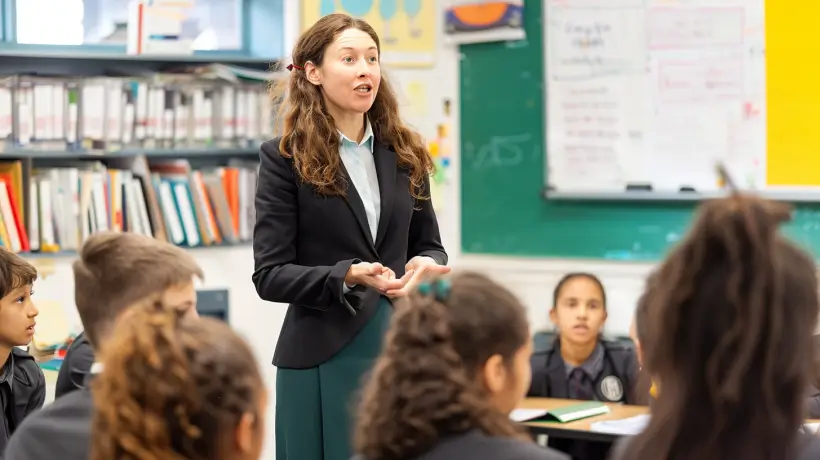
The 10 key principles are: 1) Daily review, 2) Present new material in small steps, 3) Ask questions, 4) Provide models, 5) Guide student practice, 6) Check for student understanding, 7) Obtain high success rates, 8) Provide scaffolds for difficult tasks, 9) Independent practice, and 10) Weekly and monthly review. These principles came from studying master teachers whose students showed the strongest academic progress. Each principle addresses specific limitations of working memory while building stronger pathways to long-term retention.
Rosenshine distilled his seventeen principles into ten core methods. Each one addresses a specific challenge in how students process and retain information. These aren't theoretical constructs. They're practical responses to how human memory actually works.
Start every lesson with 5-8 minutes of retrieval practice. Students need to recall prior knowledge before you introduce new content. This isn't a nice-to-have activity. It's necessary.
Working memory can only handle four items at once. When students haven't rehearsed previous learning, those older concepts occupy working memory space that new information needs. Daily review strengthens memory pathways and clears cognitive space for fresh content.
Effective review goes beyond asking "what did we cover yesterday?" Give students specific retrieval tasks. Ask them to list three causes of the Industrial Revolution. Have them explain photosynthesis to a partner. Use Map It graphic organisers to capture their recalled knowledge visually.
Students who review daily build deeper understanding over time. They spot connections between topics. Their foundational skills become automatic, freeing mental resources for complex thinking. The Extract thinking skills from the Thinking Framework give you structured prompts for .

Cognitive overload stops learning dead. When you introduce multiple concepts simultaneously, working memory gets overwhelmed. Students process nothing effectively.
Break content into single ideas. Teach one step. Check understanding. Then move forward. Experienced teachers remove irrelevant details and focus tightly on what students must know. Every additional piece of information competes for limited mental resources.
This principle demands planning. You need to identify the smallest teachable unit for each concept. What's the one thing students need to grasp before moving to the next point? Map out your lesson in discrete steps, not broad chunks.
Small steps don't mean slow teaching. They mean precise teaching. Students move faster when they understand each component clearly before tackling the next. This approach particularly matters when teaching complex procedural knowledge that builds sequentially.
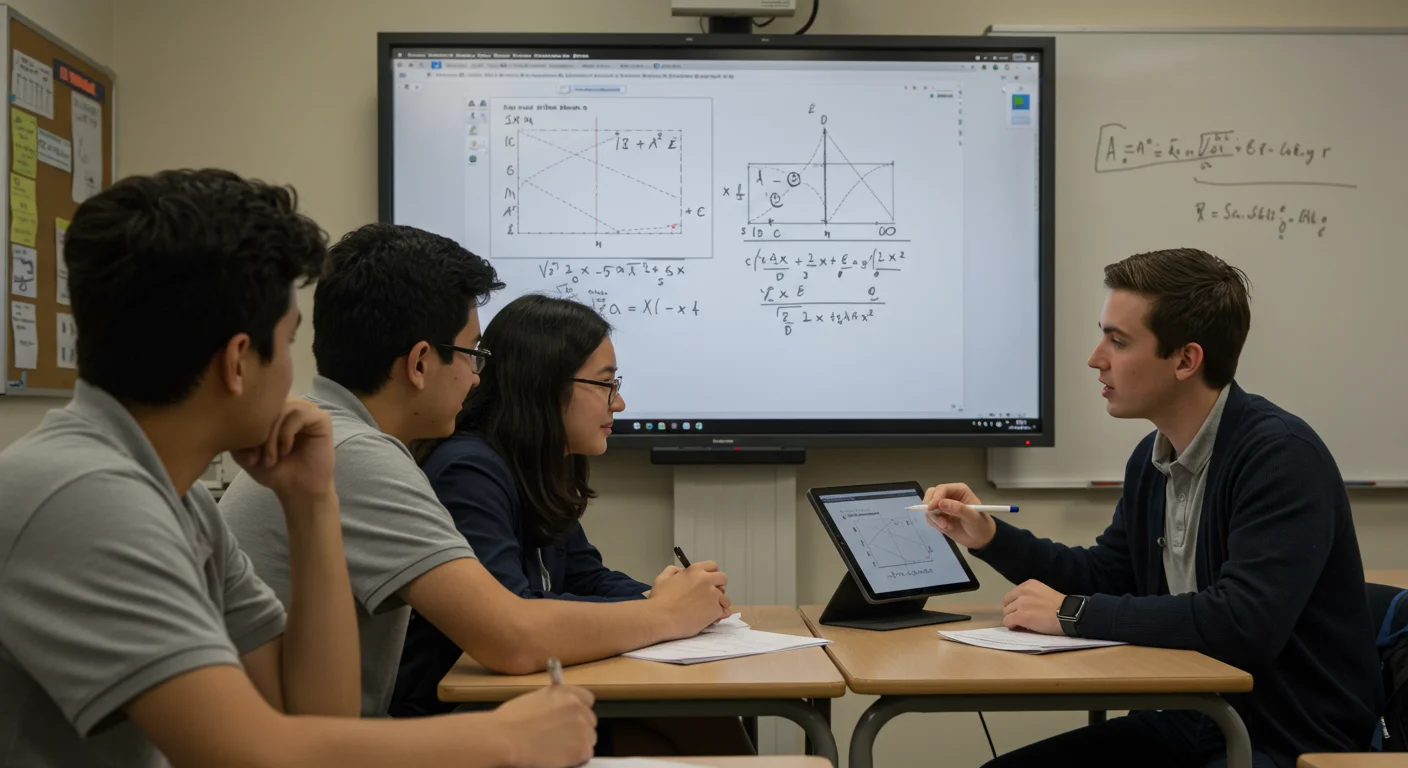
Questions serve multiple purposes. They check understanding. They force students to retrieve information. They reveal misconceptions before those errors become embedded.
Less effective teachers ask fewer questions and rarely probe students' thinking processes. Master teachers question continuously throughout instruction. They don't wait until the lesson ends to discover what students missed.
Your questions should target specific knowledge. Avoid vague prompts like "does everyone understand?" Ask questions that require students to demonstrate their grasp of the content. "What happens to the protagonist's motivation in this scene?" "How would you calculate the area if the shape were rotated?"
Use that engage all students, not just volunteers. Cold calling ensures everyone stays mentally active. gives processing time before responses. The Say It oracy tool provides structured prompts that help students articulate their thinking clearly during questioning.
Process questions matter too. Ask students to explain how they solved a problem, not just what answer they got. This reveals their thinking strategies and helps others learn different approaches.
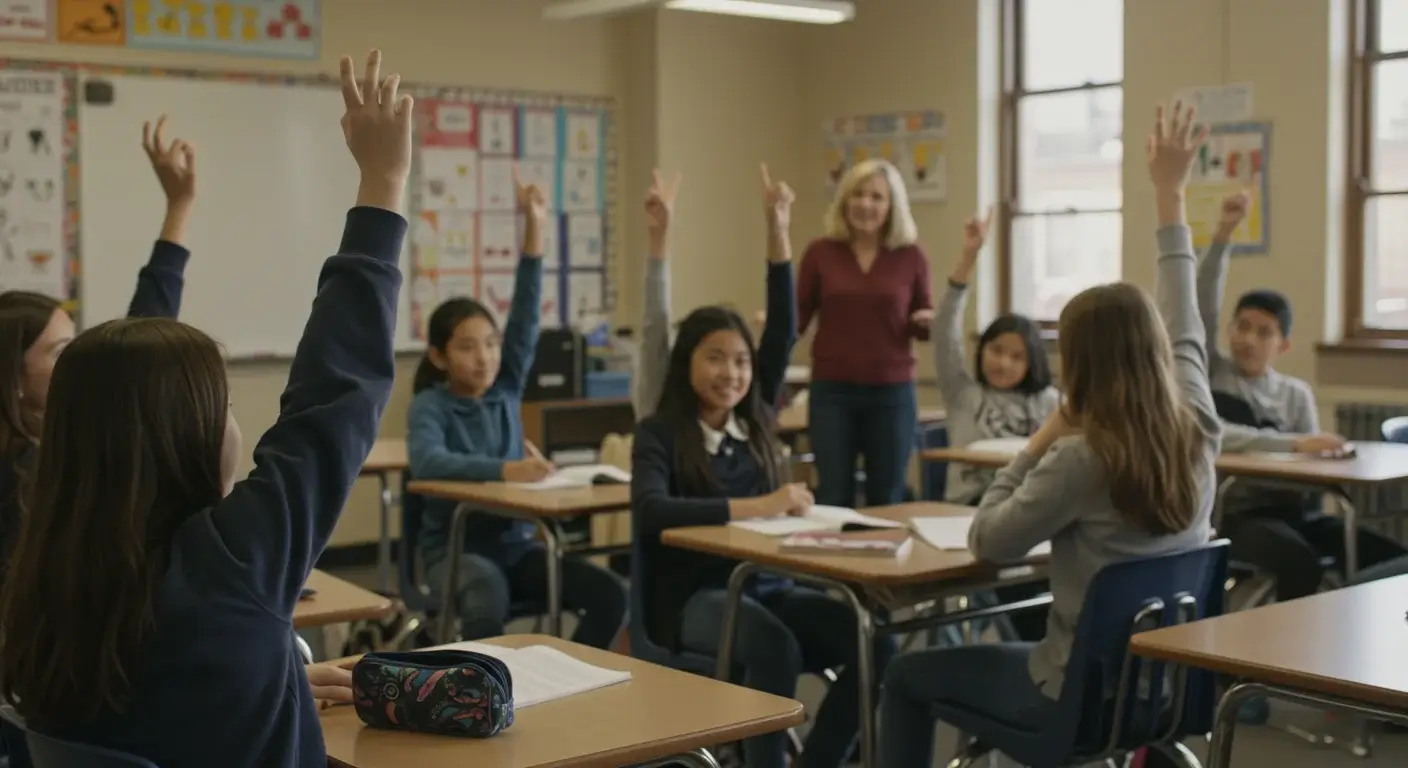
Students learn faster when you connect new information to their existing knowledge. This principle applies particularly to complex concepts that contain multiple components.
Model your thinking explicitly. Talk through your process while solving a problem. Demonstrate how you approach an essay paragraph. Show the steps you take when analyzing a source. Students can't replicate expert thinking if they never see it demonstrated.
Worked examples are powerful teaching tools. Walk students through a completed problem, explaining each decision point. Then give them a similar problem to attempt with support. This gradual release helps students build mental models of expert performance.
Thinking aloud makes your invisible mental processes visible. When you analyze a poem, verbalize how you notice patterns, make inferences, and connect to context. Students learn the cognitive moves experts make automatically. The Thinking Framework provides a menu of thinking skills you can model explicitly during instruction.
Students need extensive practice with new skills, but they shouldn't practice alone immediately. Guided practice sits between direct instruction and independent work. You remain present, monitoring attempts, correcting errors, and providing support.
This principle addresses a common teaching mistake: moving to independent practice too quickly. When students practice errors repeatedly, those mistakes become harder to correct later. Stay close during initial attempts. Circulate actively. Spot misconceptions as they emerge.
Give students sufficient time at this stage. Don't rush toward independence. Practice strengthens memory only when students practice correctly. If they're rehearsing errors, they're building fluency in the wrong methods.
Ask questions while students practice. Check their reasoning. Probe their understanding. Offer hints rather than answers when they struggle. The Writer's Block tool provides physical scaffolding during guided practice, helping students construct sentences and organize ideas while you monitor their work.
Reduce your support gradually as students demonstrate competence. This scaffolding withdrawal happens over days or weeks, not within a single lesson.

Stop teaching periodically to assess whether students have grasped the content. These checks reveal gaps you need to address before moving forward. Without them, you're building on shaky foundations.
Effective checks require students to demonstrate their understanding, not just nod along. Ask them to summarize the concept in their own words. Have them complete a quick problem. Get them to explain the idea to a partner.
Watch for patterns in responses. If multiple students share the same misconception, reteach that component immediately. Don't plow ahead hoping confusion will resolve itself. Address errors while the content is still fresh.
These understanding checks also show students whether they've learned the material. Self-assessment helps them gauge their own comprehension and identify what they need to review. Use graphic organisers to have students capture and organize their understanding visually during these checkpoint moments.
Mini-whiteboards work well for quick checks. Students write their answers and hold them up simultaneously. You scan the room and spot misconceptions instantly.

Research on direct instruction shows a consistent pattern. The most successful teachers maintain approximately 80% success rates during guided practice. This number isn't arbitrary. It represents the sweet spot where students feel challenged but not overwhelmed.
Success rates below 80% suggest the material is too difficult or your scaffolding is insufficient. Students become frustrated and disengage. Success rates above 90% indicate the work is too easy. Students aren't being stretched.
Monitor success during practice. If most students struggle, pause and reteach. Break the concept into smaller steps. Add more scaffolding. If everyone breezes through, increase the challenge.
This principle requires attention to pacing. You need to adjust instruction based on student performance, not march through your planned content regardless of comprehension. The goal is learning, not curriculum coverage.
High success rates build student confidence. When students experience consistent progress, they stay motivated and develop stronger self-efficacy. This matters particularly for students who've struggled academically in the past.
Complex material requires temporary support structures. Scaffolding helps students accomplish tasks they couldn't manage independently. As competence grows, you remove the supports gradually.
Scaffolds take many forms. Sentence stems help students structure their writing. Partially completed examples guide problem-solving. Graphic organisers provide frameworks for organizing thinking. Word banks support vocabulary development.
The key word is temporary. Scaffolding assists learning but shouldn't become permanent crutches. Your goal is to build independence, which requires gradually removing supports as students demonstrate readiness.
This principle connects directly to Vygotsky's zone of proximal development. Students work slightly beyond their current capability with appropriate support. The Thinking Framework cards serve as cognitive scaffolds, breaking complex thinking into manageable skills students can access independently.
Don't remove all scaffolds simultaneously. Fade them systematically. Take away one support while maintaining others. Let students experience success at each stage before adding more challenge.
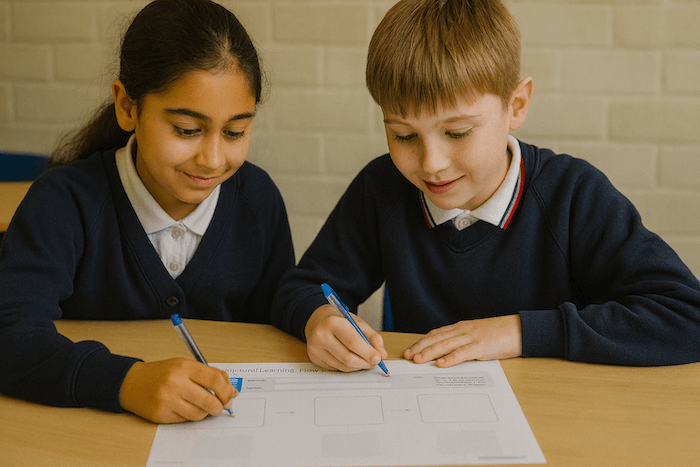
Students must eventually complete tasks without support. Independent practice builds automaticity and confidence. It also reveals whether students have truly mastered the content or were relying too heavily on your guidance.
This practice happens outside guided instruction. Students work alone, applying their skills to new problems or contexts. The practice should be extensive enough to develop fluency. One attempt isn't sufficient. Repeated successful practice creates the automaticity that frees working memory for more complex thinking.
Monitor independent practice even though students work alone. Collect their work. Check for errors. Provide feedback. Independent doesn't mean abandoned. You need to know whether practice is reinforcing correct understanding or embedding misconceptions.
Over-learning matters here. When students practice beyond initial mastery, they develop the automatic recall that makes knowledge readily accessible. This particularly applies to foundational skills like times tables, phonics, or key vocabulary that students need in multiple contexts.
Set independent practice that matches students' demonstrated capability during guided work. If they succeeded with 80% accuracy during guided practice, independent tasks should be similarly challenging.

Daily review handles recent learning. Weekly and monthly review spaces out retrieval practice over longer intervals. This combination creates what research calls successive relearning.
Spacing strengthens memory more effectively than massed practice. When students retrieve information after a gap, they work harder to access the memory. This effortful retrieval strengthens the pathway more than easy, immediate recall.
Plan these reviews strategically. Don't just review whatever feels convenient. Identify the knowledge students need to retain long-term. Build systematic review into your curriculum planning.
Weekly quizzes work well for this principle. Short tests that cover the previous week's content plus selected material from earlier units force retrieval and reveal what students have retained. Monthly reflections help students connect concepts across larger time spans.
This spaced practice prevents the forgetting curve that naturally occurs without rehearsal. Students maintain their knowledge over time rather than cramming for tests and then losing the information. Use the Categorise thinking skills to help students organize and connect concepts during these review sessions.
Make review active, not passive. Don't just re-teach the same content. Ask students to retrieve, apply, and extend their previous learning in new ways.
Modern adaptations include using digital tools for retrieval practice, incorporating spaced repetition software for reviews, and applying the principles to online and hybrid learning environments. Teachers are combining Rosenshine's framework with metacognitive strategies and self-regulated learning techniques. These innovations maintain the core cognitive science foundations while addressing contemporary educational contexts.
Rosenshine's principles haven't aged. The cognitive science behind them remains sound in 2025. But the tools teachers use to apply these principles have changed dramatically.
Classroom technology now enables teachers to implement Rosenshine's methods more effectively than he could have imagined in 2010. Digital tools don't replace good teaching. They amplify it.
Retrieval practice apps handle spaced repetition automatically. Platforms like Quizlet and Anki schedule daily, weekly, and monthly review based on each student's performance. The algorithms track when students last encountered specific content and resurface it at optimal intervals. This takes the planning burden off teachers while ensuring students benefit from the memory-strengthening effects of spaced practice.
Real-time response systems solve a persistent teaching challenge: checking understanding across an entire class simultaneously. Tools like Kahoot, Mentimeter, and classroom response systems let every student answer questions during instruction. Teachers see aggregate results instantly and spot misconceptions before moving forward. This scales Rosenshine's emphasis on constant questioning and checking for understanding.
Handheld devices that once distracted students now support learning when used deliberately. Tablets and phones give students immediate access to worked examples, vocabulary support, and graphic organiser templates. The key is structured use. Students access specific resources at designated points in the lesson, not browse freely.

AI tools have matured significantly. Teachers in 2025 use artificial intelligence to differentiate scaffolding without creating unsustainable workloads.
AI-generated worked examples adapt to individual student needs. When a student struggles with quadratic equations, the system generates additional problems with step-by-step solutions at the appropriate difficulty level. The AI varies surface features while maintaining the underlying structure students need to practice. This provides the modeling Rosenshine emphasized without requiring teachers to hand-craft dozens of examples.
Adaptive practice platforms maintain the 80% success rate Rosenshine identified as optimal. The system adjusts problem difficulty based on student performance. When success rates drop below 75%, the platform adds scaffolding or presents simpler problems. When students exceed 90% accuracy, challenge increases. This automated adjustment ensures students work consistently in their zone of proximal development.
AI feedback tools support independent practice by providing immediate, specific responses to student work. Rather than waiting days for teacher feedback, students receive guidance during practice sessions. The AI identifies patterns in errors and suggests targeted improvements. This doesn't replace teacher feedback. It supplements it, giving students more opportunities to refine their work between teacher reviews.
Natural language processing tools help with questioning techniques. AI chatbots pose increasingly sophisticated questions to students, probing their understanding and requiring them to explain their reasoning. These tools function like the Say It oracy prompts, but with infinite patience and 24-hour availability.
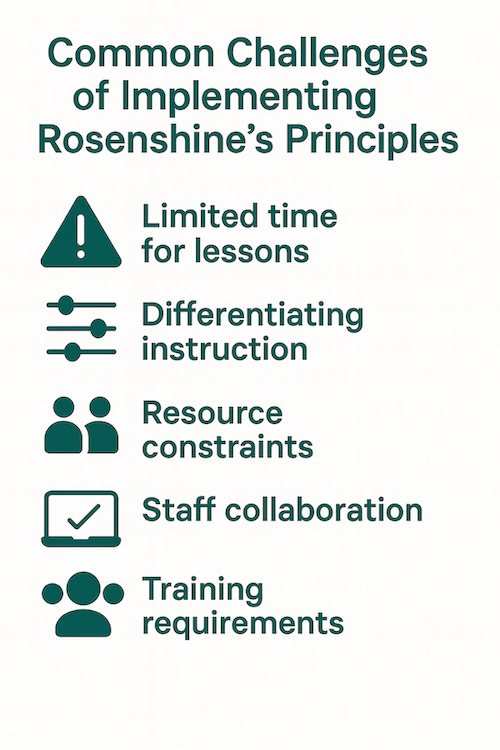
Technology amplifies teaching quality but doesn't create it. Poor instruction delivered through expensive devices remains poor instruction. Teachers need training in both Rosenshine's principles and effective technology integration.
Cognitive load concerns intensify with technology. Flashy interfaces, multiple notification systems, and competing apps can overwhelm working memory faster than any worksheet. Choose simple, focused tools that support learning objectives rather than distract from them. The Thinking Framework's emphasis on clear cognitive pathways matters more than ever when students navigate digital environments.
Equity issues persist. Not all students have reliable home internet or personal devices. Schools in 2025 must ensure technology-enhanced instruction doesn't create barriers for disadvantaged students. The principles themselves remain accessible regardless of technological resources.
Data privacy requires vigilance. AI systems that track student performance generate sensitive information. Schools need clear policies about data collection, storage, and use. Parents deserve transparency about how these systems operate.
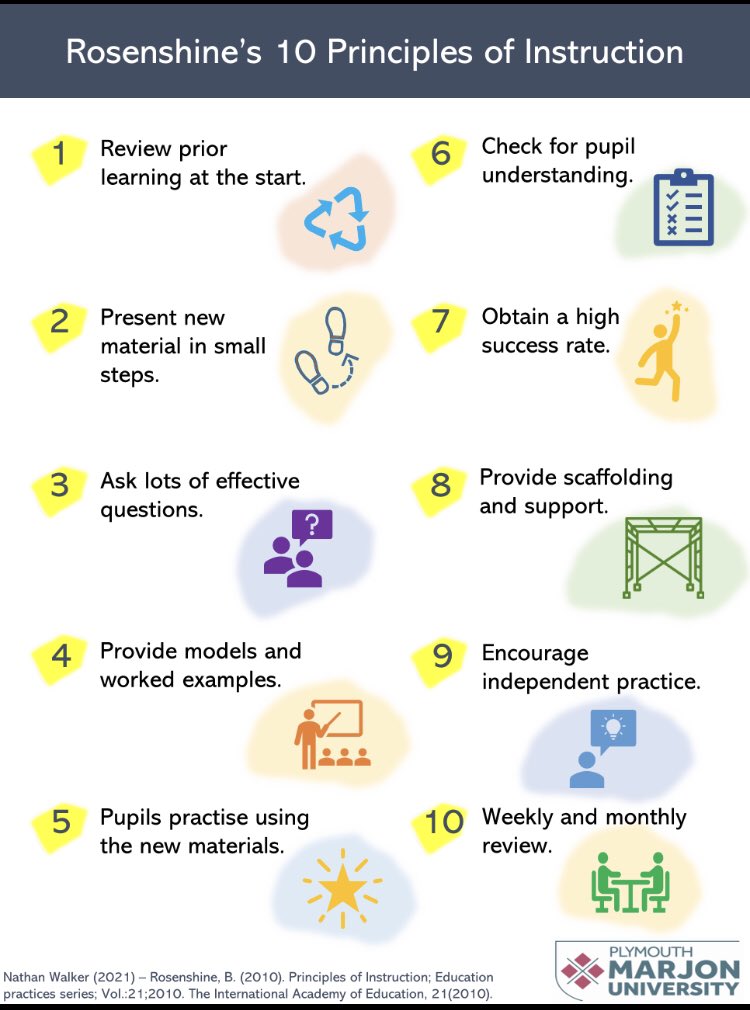
Start by incorporating daily review into the first 5 minutes of every lesson, using specific retrieval questions that activate prior knowledge. Structure new content delivery into small chunks with frequent checks for understanding through targeted questioning. Build in guided practice before independent work, ensuring students achieve at least 80% success rate before moving forward.
Implementing Rosenshine's Principles of Instruction across a school requires a strategic and thoughtful approach to ensure meaningful impact on teaching and learning. For school leaders, this involves creating an environment where these research-backed strategies can flourish in everyday classrooms. By focusing on gradual, practical implementation and ongoing support for teachers, these principles can significantly enhance student outcomes.
By taking a phased and supportive approach to rolling out Rosenshine's Principles of Instruction, school leaders can embed these ideas into the fabric of teaching and learning. This not only enhances instructional quality but also builds a culture of continual improvement and student success.

Rosenshine's principles matter because they translate cognitive science research directly into practical teaching strategies that improve student learning and retention. These evidence-based methods help teachers prevent cognitive overload while building stronger memory pathways. The principles work across all subjects, ages, and ability levels, making them universally applicable in education.
Rosenshine's principles are based on Evidence-Informed Teaching that supports their efficacy. Steven and Rosenshine's Principles (1986) advance teacher performance by applying the most effective practice of teaching when the main goal is to master a key skill or body of knowledge using clearly defined stages, which the students apply later. Some of the above educational strategies may not be beneficial in certain situations, for instance, if someone is trying to find a unique, creative solution to a problem.
For this reason, as with any academic strategy, it is up to the professional judgement of the instructor to agree on how and when to use these strategies within their teaching routines. As with all new classroom concepts, teachers will need opportunities for deliberate practice. Simply providing teaching books in the classroom is not sufficient for whole school change. Educators need opportunities to develop a theory of action and then put this into practice. As an educational idea, the principles have really developed a lot of traction in British schools over the last two years. Their simplicity enables teachers to develop a strong understanding of instructional practices.
Over the last two years, these principles have been considered effective practice and have been adopted in many schools around the UK and further afield. They offer the classroom teacher a simple way of taking ideas of practice into their own classrooms. Taking these principles into practice does require a strong conceptual understanding of the rationale behind the technique. If educators don't acquire a fundamental understanding of the educational principle, then we run the risk of engaging in instructional behaviours that we don't fully grasp.
Experienced teachers have built their craft over years of effective practice and they understand when to facilitate certain teaching practices and when to avoid them. We have seen lesson observation templates that require teachers to incorporate the Rosenshine Principles even when they are not suited to the lesson material. Our advice would be to focus on developing a strong conceptual understanding of cognitive science and instructional practices. With a strong understanding of the broad principles, the teaching staff can then choose when to incorporate strategies into the lesson sequence. If we are too prescriptive within lesson observations then we run the risk of taking Rosenshine's Principles of Instruction out of context to the detriment of student progress.

Key resources include Rosenshine's original 2012 paper 'Principles of Instruction,' Tom Sherrington's 'Rosenshine's Principles in Action,' and the Education Endowment Foundation's implementation guides. Many teacher training programs now incorporate these principles into their curricula. Online communities and professional development courses also offer practical applications and case studies.
These studies collectively underscore the efficacy of Rosenshine's principles of instruction in various educational contexts, emphasizing their impact on teaching practices and student learning outcomes.
1. Heath, R., & Nielson, M. A. (1974). The research basis for performance-based teacher education. Review of Educational Research, 44, 463-484.
Summary: This study reviews research on teacher performance and its relation to student achievement, highlighting Rosenshine's identification of key teacher behaviors like clarity and task-oriented instruction. These principles emphasize the importance of effective instructional practices in improving student outcomes.
2. Rosenshine, B., & Meyers, L. I. (1978). Staff development for teaching basic skills. Theory Into Practice, 17(3), 267-271.
Summary: Rosenshine and Meyers discuss a model of direct instruction that incorporates principles such as independent practice and daily review. The study emphasizes the need for structured teaching strategies to improve basic skills, especially for less academically inclined students.
3. Rosenshine, B. (1987). Explicit teaching and teacher training. Journal of Teacher Education, 38(3), 34-36.
Summary: This paper outlines the steps of explicit teaching based on Rosenshine's principles, including stages of practice and retrieval practice. It highlights the role of teacher training in promoting these instructional practices to enhance teaching effectiveness.
4. Mastropieri, M. (1989). Using general education teacher effectiveness literature in the preparation of special education personnel. Teacher Education and Special Education, 12(4), 170-172.
Summary: Mastropieri integrates Rosenshine's principles into a special education teacher preparation model, focusing on effective instructional practices. The study demonstrates the application of these principles in improving outcomes for special education students.
5. Good, T. (1979). Teacher effectiveness in the elementary school. Journal of Teacher Education, 30(2), 52-64.
Summary: Good's review of teacher effectiveness research highlights Rosenshine's emphasis on active teaching and structured instruction. The study discusses how these practices, including the use of students' questions and independent practice, contribute to student achievement.
Rosenshine's Principles are 17 evidence-based teaching methods developed by Professor Barak Rosenshine between 1986 and 2010 through studying master teachers whose students consistently achieved the strongest progress on attainment tests. These principles aren't based on theory or guesswork, but on actual classroom observations combined with cognitive science research about how students learn and retain information.
Begin with daily review by dedicating 5-8 minutes at the start of each lesson to retrieval practice, asking students to recall specific information from previous lessons rather than generic questions like 'what did we cover yesterday?'. Present new material in small steps and allow students to practise after each step, ensuring you don't introduce too much new content at once to prevent cognitive overload.
Rosenshine's principles are specifically designed around cognitive load management and how working memory actually functions, addressing the fact that students can only handle four items in working memory at once. The approach combines three research foundations: cognitive science on how students acquire information, observations of master teachers in action, and scaffolding research, making it more comprehensive than methods based on single theories.
Ask many targeted questions throughout lessons rather than waiting until the end, and monitor student responses closely to identify knowledge gaps before moving to new concepts. Use specific retrieval tasks and have students demonstrate their understanding actively, such as explaining concepts to partners or completing graphic organisers to make their thinking visible.
Break down complex concepts into manageable chunks and provide guided practice after each step before introducing the next part. Use worked examples to model processes explicitly, showing students the thinking steps involved, and ensure high success rates by providing scaffolding and support throughout the learning progression.
The principles strengthen pathways between working memory and long-term memory through systematic retrieval practice, daily review, and spaced repetition with weekly and monthly reviews. By preventing cognitive overload and providing structured practice progression, students build stronger memory connections that help them retain and apply knowledge over time rather than just cramming for tests.
The principles work across all subjects and age groups because they're rooted in fundamental cognitive science about how all humans process and retain information. Whether teaching primary mathematics, secondary history, or A-level sciences, the core concepts of managing cognitive load, systematic practice, and retrieval remain universally applicable, though the specific implementation will vary by context.
Barak Rosenshine wanted to know what made great teachers great. Between 1986 and 2010, this University of Illinois professor studied classrooms, reviewed cognitive science research, and identified patterns that separated clear teaching from average teaching.
The result was seventeen principles that work. Not theory. Not guesswork. These came from watching teachers whose students consistently made the strongest progress on attainment tests.
Rosenshine built his framework on three foundations. First, he examined cognitive science research on how students acquire and retain new information. Second, he observed master teachers in action, noting how they introduced content through modelling, linked new ideas to prior knowledge, checked understanding, and structured practice. Third, he studied research on scaffolding and cognitive supports that help students tackle difficult concepts.
Barak Rosenshine died in 2017, but his principles remain central to teacher training across the UK. They connect directly to how our brains process information. Working memory has limits. Long-term memory needs specific conditions to store new knowledge. These principles address both constraints.
Teachers using Rosenshine's approach create classrooms where students understand more and remember longer through mastery learning. This connects directly to the concept of visible learning, where teaching methods make student progress transparent and measurable. The principles guide questioning, practice design, and lesson structure. They work across subjects and age groups because they're rooted in how all humans learn, making them particularly effective for direct instruction approaches.
This article breaks down each principle and shows how to apply them in your classroom. If you lead teaching and learning in your school, you'll also find guidance on professional development and implementation. These aren't checklist items. They're high-level concepts that require understanding before you can apply them well. Once you grasp the cognitive science principles behind them, you can adapt your daily teaching to fit your students' needs.
The Structural Learning Thinking Framework aligns with Rosenshine's emphasis on explicit instruction and retrieval practice. When you combine both approaches, you give students clear cognitive pathways and practical tools for organizing their thinking.
You can download a visual summary of all seventeen principles as a PDF. Use it for CPD sessions, staff meetings, or your own planning. The graphic format makes the principles easy to reference when designing lessons or observing colleagues.
Rosenshine's most effective methods include daily review, presenting new material in small steps, asking questions to check understanding, providing models, guiding student practice, and obtaining high success rates. These methods work by preventing cognitive overload and strengthening connections between working memory and long-term memory. Teachers who implement these methods consistently see stronger student progress on attainment tests.
Rosenshine's principles of instruction have garnered significant attention in recent years for offering a set of flexible, evidence-informed guidelines that can be adapted to suit various teaching contexts. These principles are not rigid frameworks but rather guiding methods designed to help teachers enhance their practice while maintaining professional autonomy. In the UK, where schools increasingly value , Rosenshine's methods provide an excellent foundation for fostering clear teaching behaviours. However, for these principles to truly succeed, it is essential that teachers understand the rationale behind them. Without this clarity, there is a risk of superficial adoption without meaningful impact.
To begin, lessons should start with a brief review of prior learning, ensuring students are prepared to engage with new material. When introducing new concepts, teachers should do so in manageable steps, allowing students to practice after each step to solidify understanding. To prevent cognitive overload, it is crucial to limit the amount of new material introduced at one time and provide clear, detailed instructions and explanations. Teachers should ask many targeted questions to test understanding and ensure clarity, guiding students as they begin practicing new skills.

Active, is essential for students to develop proficiency. Teachers should model processes explicitly, using worked-out examples to illustrate steps clearly. Students should then demonstrate their understanding, enabling teachers to check their responses and provide corrections or feedback as needed. Complex material may require re-teaching to ensure comprehension. Teachers should allocate ample time for clear explanations, reinforcing key concepts and addressing gaps in knowledge.
Finally, students should be prepared for independent practice, which must be closely monitored to ensure success. By following these principles, teachers can create structured, engaging learning environments that promote student progress while adapting to the unique needs of their classrooms.

The 10 key principles are: 1) Daily review, 2) Present new material in small steps, 3) Ask questions, 4) Provide models, 5) Guide student practice, 6) Check for student understanding, 7) Obtain high success rates, 8) Provide scaffolds for difficult tasks, 9) Independent practice, and 10) Weekly and monthly review. These principles came from studying master teachers whose students showed the strongest academic progress. Each principle addresses specific limitations of working memory while building stronger pathways to long-term retention.
Rosenshine distilled his seventeen principles into ten core methods. Each one addresses a specific challenge in how students process and retain information. These aren't theoretical constructs. They're practical responses to how human memory actually works.
Start every lesson with 5-8 minutes of retrieval practice. Students need to recall prior knowledge before you introduce new content. This isn't a nice-to-have activity. It's necessary.
Working memory can only handle four items at once. When students haven't rehearsed previous learning, those older concepts occupy working memory space that new information needs. Daily review strengthens memory pathways and clears cognitive space for fresh content.
Effective review goes beyond asking "what did we cover yesterday?" Give students specific retrieval tasks. Ask them to list three causes of the Industrial Revolution. Have them explain photosynthesis to a partner. Use Map It graphic organisers to capture their recalled knowledge visually.
Students who review daily build deeper understanding over time. They spot connections between topics. Their foundational skills become automatic, freeing mental resources for complex thinking. The Extract thinking skills from the Thinking Framework give you structured prompts for .

Cognitive overload stops learning dead. When you introduce multiple concepts simultaneously, working memory gets overwhelmed. Students process nothing effectively.
Break content into single ideas. Teach one step. Check understanding. Then move forward. Experienced teachers remove irrelevant details and focus tightly on what students must know. Every additional piece of information competes for limited mental resources.
This principle demands planning. You need to identify the smallest teachable unit for each concept. What's the one thing students need to grasp before moving to the next point? Map out your lesson in discrete steps, not broad chunks.
Small steps don't mean slow teaching. They mean precise teaching. Students move faster when they understand each component clearly before tackling the next. This approach particularly matters when teaching complex procedural knowledge that builds sequentially.

Questions serve multiple purposes. They check understanding. They force students to retrieve information. They reveal misconceptions before those errors become embedded.
Less effective teachers ask fewer questions and rarely probe students' thinking processes. Master teachers question continuously throughout instruction. They don't wait until the lesson ends to discover what students missed.
Your questions should target specific knowledge. Avoid vague prompts like "does everyone understand?" Ask questions that require students to demonstrate their grasp of the content. "What happens to the protagonist's motivation in this scene?" "How would you calculate the area if the shape were rotated?"
Use that engage all students, not just volunteers. Cold calling ensures everyone stays mentally active. gives processing time before responses. The Say It oracy tool provides structured prompts that help students articulate their thinking clearly during questioning.
Process questions matter too. Ask students to explain how they solved a problem, not just what answer they got. This reveals their thinking strategies and helps others learn different approaches.

Students learn faster when you connect new information to their existing knowledge. This principle applies particularly to complex concepts that contain multiple components.
Model your thinking explicitly. Talk through your process while solving a problem. Demonstrate how you approach an essay paragraph. Show the steps you take when analyzing a source. Students can't replicate expert thinking if they never see it demonstrated.
Worked examples are powerful teaching tools. Walk students through a completed problem, explaining each decision point. Then give them a similar problem to attempt with support. This gradual release helps students build mental models of expert performance.
Thinking aloud makes your invisible mental processes visible. When you analyze a poem, verbalize how you notice patterns, make inferences, and connect to context. Students learn the cognitive moves experts make automatically. The Thinking Framework provides a menu of thinking skills you can model explicitly during instruction.
Students need extensive practice with new skills, but they shouldn't practice alone immediately. Guided practice sits between direct instruction and independent work. You remain present, monitoring attempts, correcting errors, and providing support.
This principle addresses a common teaching mistake: moving to independent practice too quickly. When students practice errors repeatedly, those mistakes become harder to correct later. Stay close during initial attempts. Circulate actively. Spot misconceptions as they emerge.
Give students sufficient time at this stage. Don't rush toward independence. Practice strengthens memory only when students practice correctly. If they're rehearsing errors, they're building fluency in the wrong methods.
Ask questions while students practice. Check their reasoning. Probe their understanding. Offer hints rather than answers when they struggle. The Writer's Block tool provides physical scaffolding during guided practice, helping students construct sentences and organize ideas while you monitor their work.
Reduce your support gradually as students demonstrate competence. This scaffolding withdrawal happens over days or weeks, not within a single lesson.

Stop teaching periodically to assess whether students have grasped the content. These checks reveal gaps you need to address before moving forward. Without them, you're building on shaky foundations.
Effective checks require students to demonstrate their understanding, not just nod along. Ask them to summarize the concept in their own words. Have them complete a quick problem. Get them to explain the idea to a partner.
Watch for patterns in responses. If multiple students share the same misconception, reteach that component immediately. Don't plow ahead hoping confusion will resolve itself. Address errors while the content is still fresh.
These understanding checks also show students whether they've learned the material. Self-assessment helps them gauge their own comprehension and identify what they need to review. Use graphic organisers to have students capture and organize their understanding visually during these checkpoint moments.
Mini-whiteboards work well for quick checks. Students write their answers and hold them up simultaneously. You scan the room and spot misconceptions instantly.

Research on direct instruction shows a consistent pattern. The most successful teachers maintain approximately 80% success rates during guided practice. This number isn't arbitrary. It represents the sweet spot where students feel challenged but not overwhelmed.
Success rates below 80% suggest the material is too difficult or your scaffolding is insufficient. Students become frustrated and disengage. Success rates above 90% indicate the work is too easy. Students aren't being stretched.
Monitor success during practice. If most students struggle, pause and reteach. Break the concept into smaller steps. Add more scaffolding. If everyone breezes through, increase the challenge.
This principle requires attention to pacing. You need to adjust instruction based on student performance, not march through your planned content regardless of comprehension. The goal is learning, not curriculum coverage.
High success rates build student confidence. When students experience consistent progress, they stay motivated and develop stronger self-efficacy. This matters particularly for students who've struggled academically in the past.
Complex material requires temporary support structures. Scaffolding helps students accomplish tasks they couldn't manage independently. As competence grows, you remove the supports gradually.
Scaffolds take many forms. Sentence stems help students structure their writing. Partially completed examples guide problem-solving. Graphic organisers provide frameworks for organizing thinking. Word banks support vocabulary development.
The key word is temporary. Scaffolding assists learning but shouldn't become permanent crutches. Your goal is to build independence, which requires gradually removing supports as students demonstrate readiness.
This principle connects directly to Vygotsky's zone of proximal development. Students work slightly beyond their current capability with appropriate support. The Thinking Framework cards serve as cognitive scaffolds, breaking complex thinking into manageable skills students can access independently.
Don't remove all scaffolds simultaneously. Fade them systematically. Take away one support while maintaining others. Let students experience success at each stage before adding more challenge.

Students must eventually complete tasks without support. Independent practice builds automaticity and confidence. It also reveals whether students have truly mastered the content or were relying too heavily on your guidance.
This practice happens outside guided instruction. Students work alone, applying their skills to new problems or contexts. The practice should be extensive enough to develop fluency. One attempt isn't sufficient. Repeated successful practice creates the automaticity that frees working memory for more complex thinking.
Monitor independent practice even though students work alone. Collect their work. Check for errors. Provide feedback. Independent doesn't mean abandoned. You need to know whether practice is reinforcing correct understanding or embedding misconceptions.
Over-learning matters here. When students practice beyond initial mastery, they develop the automatic recall that makes knowledge readily accessible. This particularly applies to foundational skills like times tables, phonics, or key vocabulary that students need in multiple contexts.
Set independent practice that matches students' demonstrated capability during guided work. If they succeeded with 80% accuracy during guided practice, independent tasks should be similarly challenging.

Daily review handles recent learning. Weekly and monthly review spaces out retrieval practice over longer intervals. This combination creates what research calls successive relearning.
Spacing strengthens memory more effectively than massed practice. When students retrieve information after a gap, they work harder to access the memory. This effortful retrieval strengthens the pathway more than easy, immediate recall.
Plan these reviews strategically. Don't just review whatever feels convenient. Identify the knowledge students need to retain long-term. Build systematic review into your curriculum planning.
Weekly quizzes work well for this principle. Short tests that cover the previous week's content plus selected material from earlier units force retrieval and reveal what students have retained. Monthly reflections help students connect concepts across larger time spans.
This spaced practice prevents the forgetting curve that naturally occurs without rehearsal. Students maintain their knowledge over time rather than cramming for tests and then losing the information. Use the Categorise thinking skills to help students organize and connect concepts during these review sessions.
Make review active, not passive. Don't just re-teach the same content. Ask students to retrieve, apply, and extend their previous learning in new ways.
Modern adaptations include using digital tools for retrieval practice, incorporating spaced repetition software for reviews, and applying the principles to online and hybrid learning environments. Teachers are combining Rosenshine's framework with metacognitive strategies and self-regulated learning techniques. These innovations maintain the core cognitive science foundations while addressing contemporary educational contexts.
Rosenshine's principles haven't aged. The cognitive science behind them remains sound in 2025. But the tools teachers use to apply these principles have changed dramatically.
Classroom technology now enables teachers to implement Rosenshine's methods more effectively than he could have imagined in 2010. Digital tools don't replace good teaching. They amplify it.
Retrieval practice apps handle spaced repetition automatically. Platforms like Quizlet and Anki schedule daily, weekly, and monthly review based on each student's performance. The algorithms track when students last encountered specific content and resurface it at optimal intervals. This takes the planning burden off teachers while ensuring students benefit from the memory-strengthening effects of spaced practice.
Real-time response systems solve a persistent teaching challenge: checking understanding across an entire class simultaneously. Tools like Kahoot, Mentimeter, and classroom response systems let every student answer questions during instruction. Teachers see aggregate results instantly and spot misconceptions before moving forward. This scales Rosenshine's emphasis on constant questioning and checking for understanding.
Handheld devices that once distracted students now support learning when used deliberately. Tablets and phones give students immediate access to worked examples, vocabulary support, and graphic organiser templates. The key is structured use. Students access specific resources at designated points in the lesson, not browse freely.

AI tools have matured significantly. Teachers in 2025 use artificial intelligence to differentiate scaffolding without creating unsustainable workloads.
AI-generated worked examples adapt to individual student needs. When a student struggles with quadratic equations, the system generates additional problems with step-by-step solutions at the appropriate difficulty level. The AI varies surface features while maintaining the underlying structure students need to practice. This provides the modeling Rosenshine emphasized without requiring teachers to hand-craft dozens of examples.
Adaptive practice platforms maintain the 80% success rate Rosenshine identified as optimal. The system adjusts problem difficulty based on student performance. When success rates drop below 75%, the platform adds scaffolding or presents simpler problems. When students exceed 90% accuracy, challenge increases. This automated adjustment ensures students work consistently in their zone of proximal development.
AI feedback tools support independent practice by providing immediate, specific responses to student work. Rather than waiting days for teacher feedback, students receive guidance during practice sessions. The AI identifies patterns in errors and suggests targeted improvements. This doesn't replace teacher feedback. It supplements it, giving students more opportunities to refine their work between teacher reviews.
Natural language processing tools help with questioning techniques. AI chatbots pose increasingly sophisticated questions to students, probing their understanding and requiring them to explain their reasoning. These tools function like the Say It oracy prompts, but with infinite patience and 24-hour availability.

Technology amplifies teaching quality but doesn't create it. Poor instruction delivered through expensive devices remains poor instruction. Teachers need training in both Rosenshine's principles and effective technology integration.
Cognitive load concerns intensify with technology. Flashy interfaces, multiple notification systems, and competing apps can overwhelm working memory faster than any worksheet. Choose simple, focused tools that support learning objectives rather than distract from them. The Thinking Framework's emphasis on clear cognitive pathways matters more than ever when students navigate digital environments.
Equity issues persist. Not all students have reliable home internet or personal devices. Schools in 2025 must ensure technology-enhanced instruction doesn't create barriers for disadvantaged students. The principles themselves remain accessible regardless of technological resources.
Data privacy requires vigilance. AI systems that track student performance generate sensitive information. Schools need clear policies about data collection, storage, and use. Parents deserve transparency about how these systems operate.

Start by incorporating daily review into the first 5 minutes of every lesson, using specific retrieval questions that activate prior knowledge. Structure new content delivery into small chunks with frequent checks for understanding through targeted questioning. Build in guided practice before independent work, ensuring students achieve at least 80% success rate before moving forward.
Implementing Rosenshine's Principles of Instruction across a school requires a strategic and thoughtful approach to ensure meaningful impact on teaching and learning. For school leaders, this involves creating an environment where these research-backed strategies can flourish in everyday classrooms. By focusing on gradual, practical implementation and ongoing support for teachers, these principles can significantly enhance student outcomes.
By taking a phased and supportive approach to rolling out Rosenshine's Principles of Instruction, school leaders can embed these ideas into the fabric of teaching and learning. This not only enhances instructional quality but also builds a culture of continual improvement and student success.

Rosenshine's principles matter because they translate cognitive science research directly into practical teaching strategies that improve student learning and retention. These evidence-based methods help teachers prevent cognitive overload while building stronger memory pathways. The principles work across all subjects, ages, and ability levels, making them universally applicable in education.
Rosenshine's principles are based on Evidence-Informed Teaching that supports their efficacy. Steven and Rosenshine's Principles (1986) advance teacher performance by applying the most effective practice of teaching when the main goal is to master a key skill or body of knowledge using clearly defined stages, which the students apply later. Some of the above educational strategies may not be beneficial in certain situations, for instance, if someone is trying to find a unique, creative solution to a problem.
For this reason, as with any academic strategy, it is up to the professional judgement of the instructor to agree on how and when to use these strategies within their teaching routines. As with all new classroom concepts, teachers will need opportunities for deliberate practice. Simply providing teaching books in the classroom is not sufficient for whole school change. Educators need opportunities to develop a theory of action and then put this into practice. As an educational idea, the principles have really developed a lot of traction in British schools over the last two years. Their simplicity enables teachers to develop a strong understanding of instructional practices.
Over the last two years, these principles have been considered effective practice and have been adopted in many schools around the UK and further afield. They offer the classroom teacher a simple way of taking ideas of practice into their own classrooms. Taking these principles into practice does require a strong conceptual understanding of the rationale behind the technique. If educators don't acquire a fundamental understanding of the educational principle, then we run the risk of engaging in instructional behaviours that we don't fully grasp.
Experienced teachers have built their craft over years of effective practice and they understand when to facilitate certain teaching practices and when to avoid them. We have seen lesson observation templates that require teachers to incorporate the Rosenshine Principles even when they are not suited to the lesson material. Our advice would be to focus on developing a strong conceptual understanding of cognitive science and instructional practices. With a strong understanding of the broad principles, the teaching staff can then choose when to incorporate strategies into the lesson sequence. If we are too prescriptive within lesson observations then we run the risk of taking Rosenshine's Principles of Instruction out of context to the detriment of student progress.

Key resources include Rosenshine's original 2012 paper 'Principles of Instruction,' Tom Sherrington's 'Rosenshine's Principles in Action,' and the Education Endowment Foundation's implementation guides. Many teacher training programs now incorporate these principles into their curricula. Online communities and professional development courses also offer practical applications and case studies.
These studies collectively underscore the efficacy of Rosenshine's principles of instruction in various educational contexts, emphasizing their impact on teaching practices and student learning outcomes.
1. Heath, R., & Nielson, M. A. (1974). The research basis for performance-based teacher education. Review of Educational Research, 44, 463-484.
Summary: This study reviews research on teacher performance and its relation to student achievement, highlighting Rosenshine's identification of key teacher behaviors like clarity and task-oriented instruction. These principles emphasize the importance of effective instructional practices in improving student outcomes.
2. Rosenshine, B., & Meyers, L. I. (1978). Staff development for teaching basic skills. Theory Into Practice, 17(3), 267-271.
Summary: Rosenshine and Meyers discuss a model of direct instruction that incorporates principles such as independent practice and daily review. The study emphasizes the need for structured teaching strategies to improve basic skills, especially for less academically inclined students.
3. Rosenshine, B. (1987). Explicit teaching and teacher training. Journal of Teacher Education, 38(3), 34-36.
Summary: This paper outlines the steps of explicit teaching based on Rosenshine's principles, including stages of practice and retrieval practice. It highlights the role of teacher training in promoting these instructional practices to enhance teaching effectiveness.
4. Mastropieri, M. (1989). Using general education teacher effectiveness literature in the preparation of special education personnel. Teacher Education and Special Education, 12(4), 170-172.
Summary: Mastropieri integrates Rosenshine's principles into a special education teacher preparation model, focusing on effective instructional practices. The study demonstrates the application of these principles in improving outcomes for special education students.
5. Good, T. (1979). Teacher effectiveness in the elementary school. Journal of Teacher Education, 30(2), 52-64.
Summary: Good's review of teacher effectiveness research highlights Rosenshine's emphasis on active teaching and structured instruction. The study discusses how these practices, including the use of students' questions and independent practice, contribute to student achievement.
Rosenshine's Principles are 17 evidence-based teaching methods developed by Professor Barak Rosenshine between 1986 and 2010 through studying master teachers whose students consistently achieved the strongest progress on attainment tests. These principles aren't based on theory or guesswork, but on actual classroom observations combined with cognitive science research about how students learn and retain information.
Begin with daily review by dedicating 5-8 minutes at the start of each lesson to retrieval practice, asking students to recall specific information from previous lessons rather than generic questions like 'what did we cover yesterday?'. Present new material in small steps and allow students to practise after each step, ensuring you don't introduce too much new content at once to prevent cognitive overload.
Rosenshine's principles are specifically designed around cognitive load management and how working memory actually functions, addressing the fact that students can only handle four items in working memory at once. The approach combines three research foundations: cognitive science on how students acquire information, observations of master teachers in action, and scaffolding research, making it more comprehensive than methods based on single theories.
Ask many targeted questions throughout lessons rather than waiting until the end, and monitor student responses closely to identify knowledge gaps before moving to new concepts. Use specific retrieval tasks and have students demonstrate their understanding actively, such as explaining concepts to partners or completing graphic organisers to make their thinking visible.
Break down complex concepts into manageable chunks and provide guided practice after each step before introducing the next part. Use worked examples to model processes explicitly, showing students the thinking steps involved, and ensure high success rates by providing scaffolding and support throughout the learning progression.
The principles strengthen pathways between working memory and long-term memory through systematic retrieval practice, daily review, and spaced repetition with weekly and monthly reviews. By preventing cognitive overload and providing structured practice progression, students build stronger memory connections that help them retain and apply knowledge over time rather than just cramming for tests.
The principles work across all subjects and age groups because they're rooted in fundamental cognitive science about how all humans process and retain information. Whether teaching primary mathematics, secondary history, or A-level sciences, the core concepts of managing cognitive load, systematic practice, and retrieval remain universally applicable, though the specific implementation will vary by context.